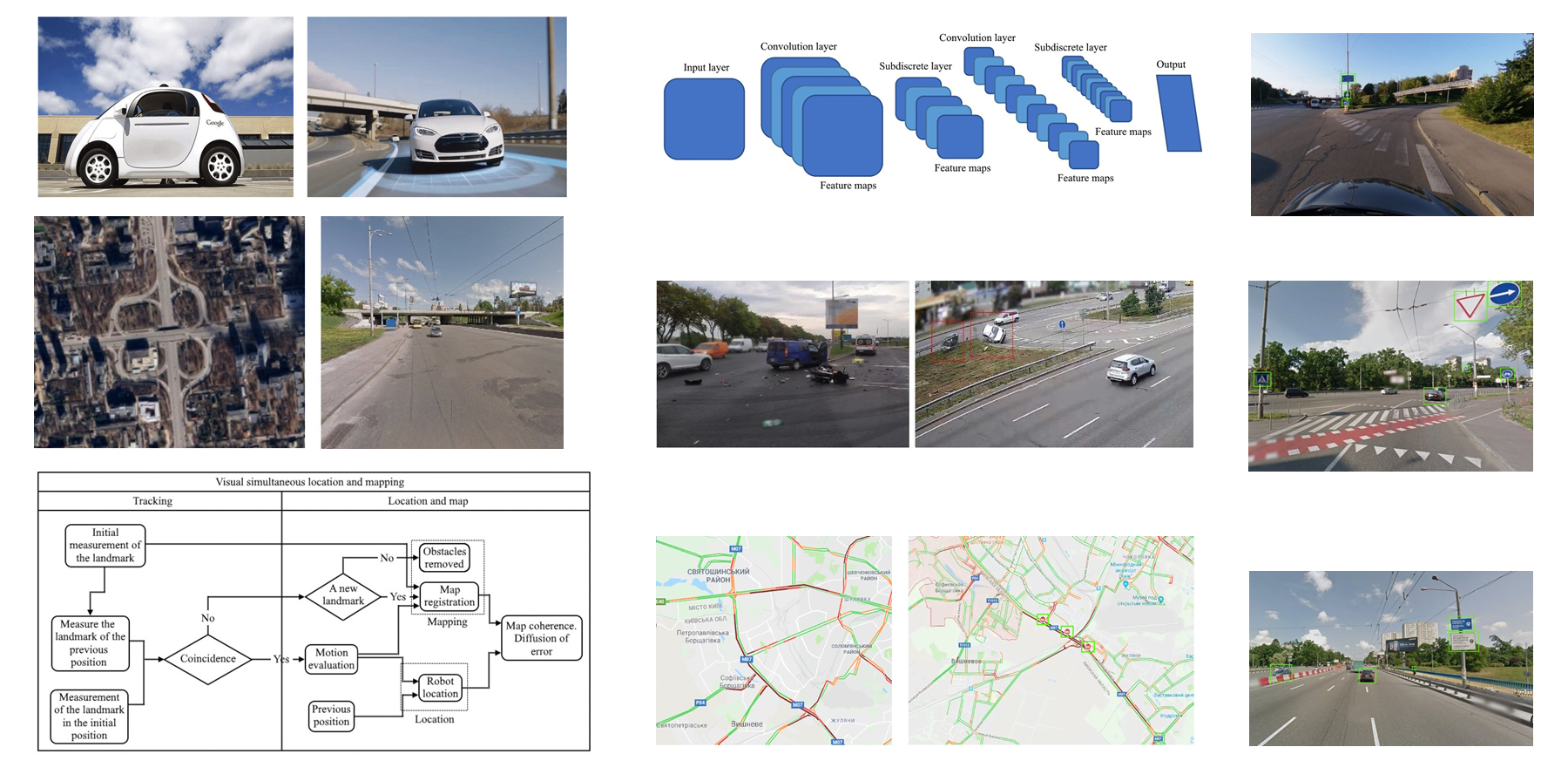Цифрові можливості ідентифікації та розпізнавання образів за допомогою методів машинного навчання, систем навігації та відеоспостереження
DOI:
https://doi.org/10.15587/2706-5448.2024.297044Ключові слова:
безпілотний транспортний засіб, згорткові нейронні мережі, розпізнавання образів, машинне навчання, навігація, планування, відеоспостереженняАнотація
Об’єктами дослідження є безпілотні транспортні засоби та розгалуження мосту міста Києва (Україна), який сполучає між собою Велику Окружну дорогу, Житомирське шосе та проспект Перемоги. Були проаналізовані побудовані маршрути з використанням технології розпізнання автодорожніх знаків, людей та автотранспортних засобів. Важливою проблемою даного дослідження є проведення аналізу можливостей з виявлення перешкод безпілотним транспортним засобом за допомогою розпізнавання образів, що поєднує в собі методи машинного зв’язку, навігацію та відеоспостереження в режимі реального часу.
На основі проведеного дослідження були отримані результати виявлення та уникнення перешкод на автодорожньому шляху, де проводилося дослідження з вивченням основних причин, які можуть спричинити затримки у часі (затори, погодні умови, ДТП). Отримано результати планування та навігації для визначення доцільного автодорожнього маршруту, що дозволяє виявляти та усувати перешкоди на дорожньому шляху, а також завчасно побудувати картографічний план маршруту за допомогою використання онлайн-сервісів з картами (Google Maps). Показано, що розпізнавання автодорожніх знаків (на основі класифікації з використанням карти дорожніх знаків, яка складається з 7 категорій), людей та автотранспортних засобів, зводить до мінімуму виникнення дорожньо-транспортних пригод, заторів та затримки у часі. Для розпізнавання образів дорожніх знаків, людей та автотранспортних засобів досліджувалися автодорожні ділянки, які сполучаються з розгалуженим мостом.
Таким чином, авторами було розглянуто та проаналізовано цифрові можливості ідентифікації та розпізнавання образів за допомогою методів машинного навчання, систем навігації та відеоспостереження, де вагоме значення відіграє безпека руху автомобільних засобів з виявленням на шляху автодорожніх знаків та перешкод. Отримані результати можуть доповнити можливості використання безпілотних транспортних засобів з метою уникнення перешкод та дорожньо-транспортних пригод на основі навченої системи для розпізнавання образів. Ця система за допомогою згорткових нейронних мереж та систем навігації з відеоспостереженням зможе забезпечити водія та оточуючих людей навколо безпечними умовами під час дорожнього руху.
Посилання
- Rezwan, S., Choi, W. (2022). Artificial Intelligence Approaches for UAV Navigation: Recent Advances and Future Challenges. IEEE Access, 10, 26320–26339. doi: https://doi.org/10.1109/access.2022.3157626
- Ni, J., Chen, Y., Chen, Y., Zhu, J., Ali, D., Cao, W. (2020). A Survey on Theories and Applications for Self-Driving Cars Based on Deep Learning Methods. Applied Sciences, 10 (8), 2749. doi: https://doi.org/10.3390/app10082749
- Kamble, S. J., Kounte, M. R. (2020). Machine Learning Approach on Traffic Congestion Monitoring System in Internet of Vehicles. Procedia Computer Science, 171, 2235–2241. doi: https://doi.org/10.1016/j.procs.2020.04.241
- Bachute, M. R., Subhedar, J. M. (2021). Autonomous Driving Architectures: Insights of Machine Learning and Deep Learning Algorithms. Machine Learning with Applications, 6, 100164. doi: https://doi.org/10.1016/j.mlwa.2021.100164
- Ali, K. S., Abid, N. M. (2021). The Importance of Google Maps for Traffic in Calculating the Level of Service for the Road and Traffic Delay. IOP Conference Series: Materials Science and Engineering, 1076 (1), 012015. doi: https://doi.org/10.1088/1757-899x/1076/1/012015
- Gupta, A., Anpalagan, A., Guan, L., Khwaja, A. S. (2021). Deep learning for object detection and scene perception in self-driving cars: Survey, challenges, and open issues. Array, 10, 100057. doi: https://doi.org/10.1016/j.array.2021.100057
- Benito-Picazo, J., Domínguez, E., Palomo, E. J., López-Rubio, E. (2020). Deep learning-based video surveillance system managed by low cost hardware and panoramic cameras. Integrated Computer-Aided Engineering, 27 (4), 373–387. doi: https://doi.org/10.3233/ica-200632
- Duarte, F. (2019). Self-driving cars: A city perspective. Science Robotics, 4 (28). doi: https://doi.org/10.1126/scirobotics.aav9843
- Hasan, N., Anzum, T., Jahan, N. (2021). Traffic sign recognition system (TSRS): SVM and convolutional neural network. Inventive Communication and Computational Technologies: Proceedings of ICICCT 2020. Springer, 69–79.
- Holovatsky, I. V., Kornaha, Yа. I. (2019). Intellectual system of recognition of road elements. Scientific Notes of Taurida National V. I. Vernadsky University. Series: Technical Sciences, 6 (1), 47–50. doi: https://doi.org/10.32838/2663-5941/2019.6-1/09
- Yan, C., Jiang, H., Zhang, B., Coenen, F. (2015). Recognizing driver inattention by convolutional neural networks. 2015 8th International Congress on Image and Signal Processing (CISP), 680–685. doi: https://doi.org/10.1109/cisp.2015.7407964
- Derrow-Pinion, A., She, J., Wong, D., Lange, O., Hester, T., Perez, L. et al. (2021). ETA Prediction with Graph Neural Networks in Google Maps. Proceedings of the 30th ACM International Conference on Information & Knowledge Management, 3767–3776. doi: https://doi.org/10.1145/3459637.3481916
- Badrloo, S., Varshosaz, M., Pirasteh, S., Li, J. (2022). Image-Based Obstacle Detection Methods for the Safe Navigation of Unmanned Vehicles: A Review. Remote Sensing, 14 (15), 3824. doi: https://doi.org/10.3390/rs14153824
- O’Mahony, N., Campbell, S., Krpalkova, L., Riordan, D., Walsh, J., Murphy, A., Ryan, C. (2018). Deep Learning for Visual Navigation of Unmanned Ground Vehicles : A review. 2018 29th Irish Signals and Systems Conference (ISSC). doi: https://doi.org/10.1109/issc.2018.8585381
- Konovalov, O. Yu. (2021). Rozrobka pidsystemy rozpiznavannia dorozhnikh znakiv avtomobilnoho avtopilota. Kharkiv, 82.
- Kanagaraj, N., Hicks, D., Goyal, A., Tiwari, S., Singh, G. (2021). Deep learning using computer vision in self driving cars for lane and traffic sign detection. International Journal of System Assurance Engineering and Management, 12 (6), 1011–1025. doi: https://doi.org/10.1007/s13198-021-01127-6

##submission.downloads##
Опубліковано
Як цитувати
Номер
Розділ
Ліцензія
Авторське право (c) 2024 Olena Marchenko, Oleksandr Viunenko, Ihor Nechai

Ця робота ліцензується відповідно до Creative Commons Attribution 4.0 International License.
Закріплення та умови передачі авторських прав (ідентифікація авторства) здійснюється у Ліцензійному договорі. Зокрема, автори залишають за собою право на авторство свого рукопису та передають журналу право першої публікації цієї роботи на умовах ліцензії Creative Commons CC BY. При цьому вони мають право укладати самостійно додаткові угоди, що стосуються неексклюзивного поширення роботи у тому вигляді, в якому вона була опублікована цим журналом, але за умови збереження посилання на першу публікацію статті в цьому журналі.








